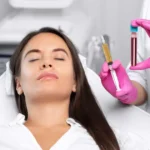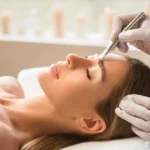
The Benefits of Platelet-Rich Plasma (PRP) Therapy for Skin and Hair
November 22, 2024
The Role of Dermaplaning in Preparing Your Skin for Special Events
January 27, 2025Testosterone Replacement Therapy (TRT) is an increasingly popular treatment for both men and women experiencing symptoms of low testosterone. For many, testosterone pellets provide a convenient, long-lasting option, releasing a steady dose of testosterone for up to six months. At JSJ Aesthetics in Salem, NH, we specialize in helping patients regain balance and vitality through customized Hormone Replacement Therapy (HRT) solutions, including testosterone pellet insertion.
While the procedure is minimally invasive, aftercare is essential to prevent complications. This guide outlines practical aftercare tips for testosterone pellet insertion so you can enjoy the benefits of this treatment with confidence.
What to Expect Immediately After Your Testosterone Pellet Insertion
The Insertion Procedure in Brief
Testosterone pellet insertion is performed under local anesthesia and typically takes only a few minutes. The pellets, which are the size of rice grains, are implanted in the hip or buttocks area. Once in place, they gradually release testosterone over time, supporting consistent hormone levels without requiring frequent injections or topical applications.
Common Post-Procedure Experiences
It’s normal to experience minor discomfort, swelling, or bruising around the insertion site during the first 24-48 hours. Some patients may also notice slight redness or itching, which resolves without intervention. While these effects are generally mild, knowing how to care for the area can speed recovery and reduce the risk of complications.
Essential Aftercare Tips for Testosterone Pellet Insertion
1. Keep the Area Clean and Dry
During the first 48 hours after the procedure:
- Avoid showering or getting the area wet.
- Clean the site gently with a soft, dry cloth if needed.
- Avoid applying lotions, creams, or other products directly over the insertion site.
2. Avoid Heavy Lifting or Strenuous Activity
For at least 3-5 days:
- Refrain from activities that put pressure on the insertion area, such as heavy lifting, intense workouts, or long periods of sitting.
- Light activities like walking are fine but avoid bending or stretching excessively.
This precaution minimizes movement at the insertion site, helping the pellet settle and reducing the risk of displacement or infection.
Monitoring the Insertion Site for Signs of Infection
Recognizing Normal vs. Concerning Symptoms
While minor swelling and tenderness are expected, contact your healthcare provider if you notice:
- Persistent or worsening redness
- Significant swelling
- Yellow or green discharge
- Fever or chills
These symptoms could indicate an infection requiring medical attention.
Lifestyle Adjustments to Support Hormone Replacement Therapy (HRT)
1. Stay Consistent with Follow-Up Appointments
Monitoring your progress requires regular follow-up visits. Testosterone levels may need to be evaluated periodically to ensure your dosage is appropriate and to adjust treatment as needed.
2. Prioritize a Healthy Diet
Hormone therapy works best when combined with a balanced diet. Focus on foods rich in:
- Lean proteins
- Healthy fats
- Whole grains
- Vitamins and minerals that support hormone balance, such as zinc, magnesium, and vitamin D
3. Maintain an Active Lifestyle
While avoiding strenuous activity immediately after the procedure is important, staying active long-term can amplify the benefits of testosterone therapy. Activities that build muscle mass, improve bone density, and enhance cardiovascular health are especially beneficial.
Common Questions About Testosterone Pellet Aftercare
1. When Can I Resume Normal Activities?
Most patients can return to work and regular activities within a day or two, provided they refrain from heavy lifting or vigorous exercise during the first week.
2. Will I Feel the Pellet Under My Skin?
It’s unlikely. The pellets are placed in a deep subcutaneous layer and are not typically noticeable once the insertion site heals.
3. How Soon Will I Notice Results?
Many patients notice improved energy, mood, and libido within 2-4 weeks. However, full benefits may take up to three months as hormone levels stabilize.
Why Choose Testosterone Replacement Therapy (TRT) in Salem, NH?
At JSJ Aesthetics, our expertise in Testosterone Replacement Therapy in Salem, NH, ensures a safe and effective experience tailored to your needs. Whether you’re managing low testosterone symptoms like fatigue, muscle loss, or reduced libido or exploring hormone therapy options as a postmenopausal woman, we are here to support your journey to improved health and vitality.
Long-Term Care and Lifestyle Tips for Sustaining Testosterone Pellet Benefits
Once you’ve recovered from your testosterone pellet insertion, the focus shifts to maintaining and maximizing the benefits of Testosterone Replacement Therapy (TRT). While the pellets offer a steady release of testosterone, your overall lifestyle plays a critical part in how well the treatment works and how long the effects last. Below are some strategies and tips to ensure you get the most out of your hormone therapy.
1. Stay Hydrated and Support Hormonal Balance Naturally
Your body’s natural processes can be supported by hydration. Hormonal balance requires proper hydration to ensure that your cells function optimally. Testosterone influences various systems in your body, from metabolism to muscle recovery, and staying hydrated helps maintain these processes.
Tips for Staying Hydrated:
- If you are physically active, drink 8 glasses (64 ounces) of water daily.
- Consume hydrating foods like cucumbers, watermelon, and leafy greens.
- Avoid dehydrating beverages, such as alcohol and caffeine, as they can affect hormone levels and overall health.
2. Incorporate Resistance Training and Physical Activity
Testosterone supports muscle growth, strength, and endurance. Regular physical activity, particularly resistance training, can amplify these benefits and promote better long-term results.
Recommended Exercises:
- Weightlifting: Use compound movements such as squats, deadlifts, and bench presses to engage multiple muscles simultaneously.
- Bodyweight Exercises: Push-ups, pull-ups, and lunges are excellent for maintaining strength without needing gym equipment.
- Cardiovascular Activity: Balance your training with activities like brisk walking, cycling, or swimming to support heart health and overall stamina.
Exercise Frequency:
- Aim for 150 minutes of moderate or 75 minutes of vigorous exercise per week, with strength training sessions occurring two to three times weekly.
3. Manage Stress to Protect Your Hormone Levels
Chronic stress can disrupt your hormonal balance by increasing cortisol levels, which may counteract the benefits of testosterone therapy. Taking steps to manage stress improves your mental well-being and supports the effectiveness of Hormone Replacement Therapy (HRT).
Stress Management Techniques:
- Mindfulness Practices: Meditation, yoga, or deep-breathing exercises can help reduce stress and promote relaxation.
- Time Management: Set priorities and delegate responsibilities to avoid feeling overwhelmed.
- Quality Sleep: Get 7-9 hours of sleep per night to allow your body to recover and regulate hormone production effectively.
4. Monitor Your Progress with Regular Check-Ups
Regular monitoring is essential to ensure your testosterone levels remain within target ranges and determine the overall effectiveness of your therapy. Your provider at JSJ Aesthetics may recommend periodic blood tests to evaluate testosterone levels, liver function, and other important health markers.
Benefits of Regular Monitoring:
- Allows for adjustments to your dosage or treatment frequency if needed.
- Helps identify any potential side effects early.
- Ensures that the therapy continues to meet your health and wellness goals.
What to Discuss During Check-Ups:
- Any new symptoms or changes you’ve noticed.
- Your energy levels, mood, and overall well-being.
- Lifestyle changes include new medications, diet adjustments, or fitness routines.
5. Avoid Lifestyle Habits That Can Undermine Your Results
Certain lifestyle choices can interfere with the benefits of Testosterone Replacement Therapy (TRT). To maximize your outcomes:
- Avoid Smoking: Smoking has been linked to lower testosterone levels and reduced cardiovascular health.
- Limit Alcohol Consumption: Excessive alcohol can negatively impact hormone levels and liver function.
- Minimize Processed Foods: Diets high in sugar, unhealthy fats, and refined carbohydrates can disrupt hormonal balance.
By avoiding these habits, you create a supportive environment for the long-term success of your treatment.
6. Keep an Open Line of Communication with Your Provider
Your relationship with your healthcare provider is key to achieving your desired outcomes. At JSJ Aesthetics, we are committed to working with you to tailor your hormone therapy plan and provide the support you need.
Why Communication Matters:
- Ensures that your therapy evolves with your needs.
- Allows for early identification and resolution of any side effects or concerns.
- Builds trust and confidence in your treatment plan.
Conclusion
Proper aftercare following your testosterone pellet insertion is crucial for achieving optimal results. At JSJ Aesthetics, we’re dedicated to providing comprehensive support throughout your hormone replacement journey. Whether you’re new to Testosterone Replacement Therapy (TRT) in Salem, NH, or continuing your treatment, our experienced team guides you through every step.
Ready to learn more about testosterone pellet therapy or need support with your current treatment? Book your consultation today or Call or text us at (603) 212-6530. Let us help you achieve your optimal hormone balance and overall well-being.
Contact us to discuss how we can support your health goals through personalized hormone therapy.


